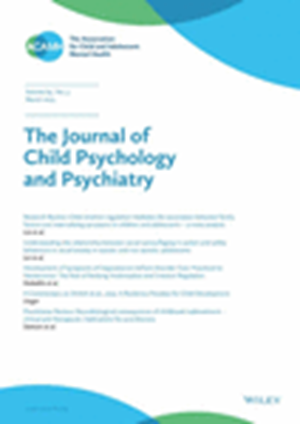研究综述:在ABCD研究®中青春期数据的(错误)使用-系统综述,问题说明和前进路径
IF 7
1区 医学
Q1 PSYCHIATRY
引用次数: 0
摘要
青少年大脑认知发展(ABCD)研究®在揭示不同美国青少年青春期发展的性质、原因、背景和后果方面具有重要的潜力。数据的最佳使用需要对青春期进行深思熟虑的考虑:它可能如何影响心理和神经发育,以及它的测量方法。我们研究了ABCD青春期数据是如何使用的,以及来自青春期发育量表的两种测量方法的相对优势:数据发布中提供的分类测量方法和在ABCD之外广泛使用的连续测量方法。首先,我们根据PRISMA指南,对截至2024年12月的已发表的ABCD青春期数据进行了回顾。两名独立的评分员根据关键特征对研究进行编码。其次,我们使用ABCD基线和第一年随访的数据,对描述性、可靠性、性别差异、双胞胎相似性的分类和连续测量进行实证比较,并检查对应关系。结果来自190份报告的系统评价结果显示,更多的研究将青春期作为协变量(72%)而不是感兴趣的变量(28%),44%的研究使用数据发布的分类测量,另外28%的研究提供的信息不足,无法确定测量方法。当青春期是一个焦点时,在使用青少年与父母的报告和缺失数据的方法方面存在差异,并且很少关注性别差异。实证比较结果表明,连续测度在数据可用性、发展分布和可靠性方面优于分类测度;他们还证实了青春期早期青少年报告的有限效用。结论:该结果对ABCD青春期数据的使用具有重要意义,尤其是早期评估。他们强调研究青春期对青少年发展的影响的复杂性,并强调测量。对这些问题的关注将最大限度地发挥ABCD的潜力,严格描述青春期在大脑和行为发育中的作用,并最终促进青少年的健康。本文章由计算机程序翻译,如有差异,请以英文原文为准。
Research Review: On the (mis)use of puberty data in the ABCD Study® – a systematic review, problem illustration, and path forward
BackgroundThe Adolescent Brain Cognitive DevelopmentSM (ABCD) Study® has significant potential to reveal the nature, causes, context, and consequences of pubertal development in diverse American youth. Optimal use of the data requires thoughtful consideration of puberty: how it is likely to affect psychological and neural development, and its measurement. We examined how ABCD puberty data have been used, and the relative advantages of two measures derived from the Pubertal Development Scale: the categorical measure provided in data releases and a continuous measure widely used outside ABCD.MethodsFirst, we conducted a review of published studies using ABCD puberty data through December 2024, following PRISMA guidelines. Two independent raters coded the studies for key features. Second, we used data from ABCD baseline and the Year 1 follow‐up to empirically compare the categorical and continuous measures in descriptives, reliability, sex differences, twin similarities, and examine correspondence.ResultsSystematic review results from 190 reports showed that more studies considered puberty as a covariate (72%) than a variable of interest (28%), with 44% using the categorical measure from data releases and another 28% providing insufficient information to determine measurement. When puberty was a focus, there was variability in the use of youth versus parent‐report and approach to missing data, and little attention to sex differences. Results from the empirical comparison showed advantages of the continuous over the categorical measure in data availability, developmental distributions, and reliability; they also confirmed the limited utility of youth‐report in early puberty.ConclusionsResults have crucial implications for the use of ABCD puberty data, especially early assessments. They highlight the complexity of studying pubertal influences on adolescent development and emphasize measurement. Attention to these issues will maximize the potential of ABCD to rigorously delineate the role of puberty in brain and behavioral development and to ultimately promote youth well‐being.
求助全文
通过发布文献求助,成功后即可免费获取论文全文。
去求助
来源期刊
CiteScore
13.80
自引率
5.30%
发文量
169
审稿时长
1 months
期刊介绍:
The Journal of Child Psychology and Psychiatry (JCPP) is a highly regarded international publication that focuses on the fields of child and adolescent psychology and psychiatry. It is recognized for publishing top-tier, clinically relevant research across various disciplines related to these areas. JCPP has a broad global readership and covers a diverse range of topics, including:
Epidemiology: Studies on the prevalence and distribution of mental health issues in children and adolescents.
Diagnosis: Research on the identification and classification of childhood disorders.
Treatments: Psychotherapeutic and psychopharmacological interventions for child and adolescent mental health.
Behavior and Cognition: Studies on the behavioral and cognitive aspects of childhood disorders.
Neuroscience and Neurobiology: Research on the neural and biological underpinnings of child mental health.
Genetics: Genetic factors contributing to the development of childhood disorders.
JCPP serves as a platform for integrating empirical research, clinical studies, and high-quality reviews from diverse perspectives, theoretical viewpoints, and disciplines. This interdisciplinary approach is a key feature of the journal, as it fosters a comprehensive understanding of child and adolescent mental health.
The Journal of Child Psychology and Psychiatry is published 12 times a year and is affiliated with the Association for Child and Adolescent Mental Health (ACAMH), which supports the journal's mission to advance knowledge and practice in the field of child and adolescent mental health.

 求助内容:
求助内容: 应助结果提醒方式:
应助结果提醒方式:


